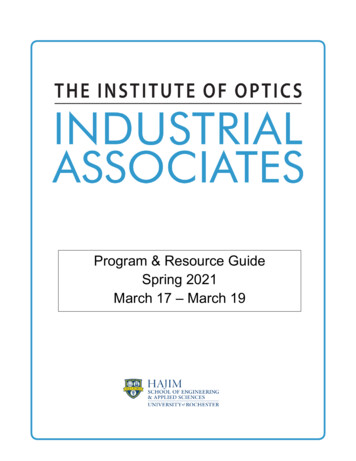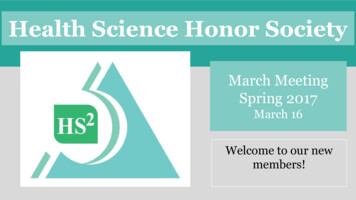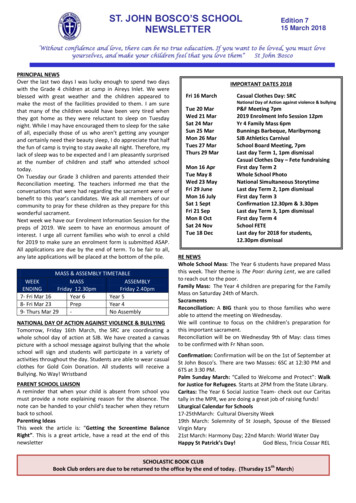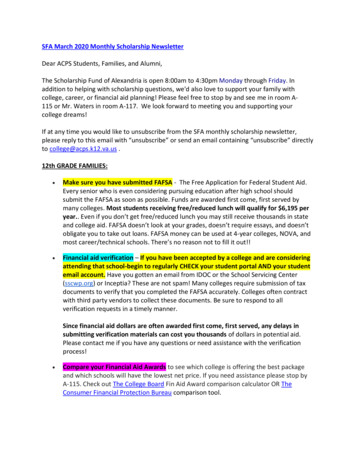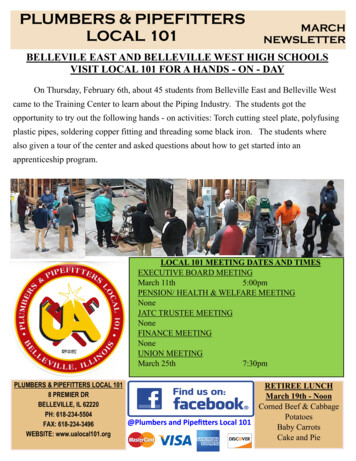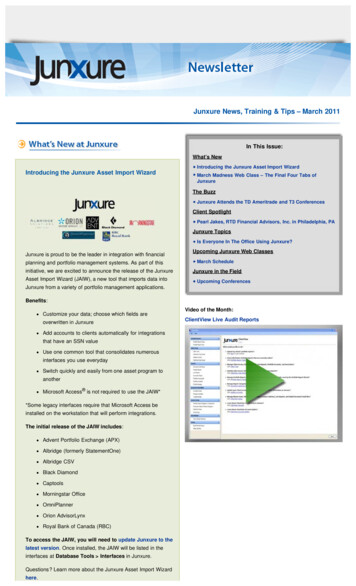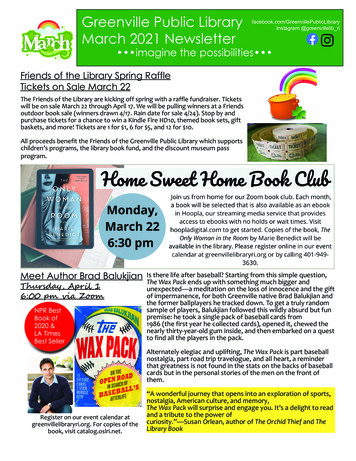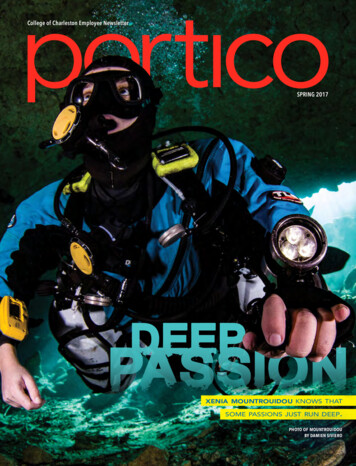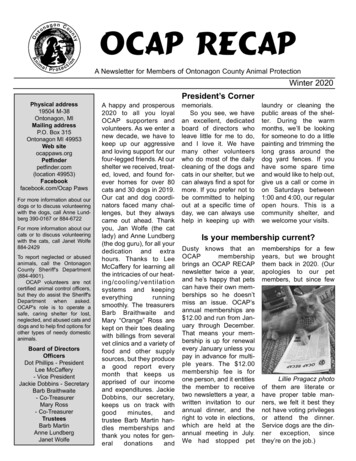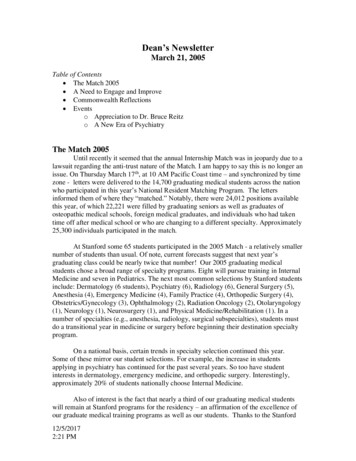
Transcription
Dean’s NewsletterMarch 21, 2005Table of Contents The Match 2005 A Need to Engage and Improve Commonwealth Reflections Eventso Appreciation to Dr. Bruce Reitzo A New Era of PsychiatryThe Match 2005Until recently it seemed that the annual Internship Match was in jeopardy due to alawsuit regarding the anti-trust nature of the Match. I am happy to say this is no longer anissue. On Thursday March 17th, at 10 AM Pacific Coast time – and synchronized by timezone - letters were delivered to the 14,700 graduating medical students across the nationwho participated in this year’s National Resident Matching Program. The lettersinformed them of where they “matched.” Notably, there were 24,012 positions availablethis year, of which 22,221 were filled by graduating seniors as well as graduates ofosteopathic medical schools, foreign medical graduates, and individuals who had takentime off after medical school or who are changing to a different specialty. Approximately25,300 individuals participated in the match.At Stanford some 65 students participated in the 2005 Match - a relatively smallernumber of students than usual. Of note, current forecasts suggest that next year’sgraduating class could be nearly twice that number! Our 2005 graduating medicalstudents chose a broad range of specialty programs. Eight will pursue training in InternalMedicine and seven in Pediatrics. The next most common selections by Stanford studentsinclude: Dermatology (6 students), Psychiatry (6), Radiology (6), General Surgery (5),Anesthesia (4), Emergency Medicine (4), Family Practice (4), Orthopedic Surgery (4),Obstetrics/Gynecology (3), Ophthalmology (2), Radiation Oncology (2), Otolaryngology(1), Neurology (1), Neurosurgery (1), and Physical Medicine/Rehabilitation (1). In anumber of specialties (e.g., anesthesia, radiology, surgical subspecialties), students mustdo a transitional year in medicine or surgery before beginning their destination specialtyprogram.On a national basis, certain trends in specialty selection continued this year.Some of these mirror our student selections. For example, the increase in studentsapplying in psychiatry has continued for the past several years. So too have studentinterests in dermatology, emergency medicine, and orthopedic surgery. Interestingly,approximately 20% of students nationally choose Internal Medicine.Also of interest is the fact that nearly a third of our graduating medical studentswill remain at Stanford programs for the residency – an affirmation of the excellence ofour graduate medical training programs as well as our students. Thanks to the Stanford12/5/20172:21 PM
Medical Alumni Association, students, family and friends celebrated this importantmilestone at the Tenth Annual Match Day Celebration on Thursday evening at theStanford Faculty Club. As always it was a special event and I want to thank the SMAAfor hosting it.I also want to thank the graduating class for their wonderful participation in thisyear’s Medical Student Gift Challenge. Remarkably, more than 93% of studentsparticipated in this gift. This level of support is truly outstanding, and. I want to expressmy deep appreciation and admiration to everyone in the graduating class.Following is the list of our graduating students and the programs to which they“Matched.” Please join me in extending our congratulations and best wishes to this year’sgraduating medical school class.2005 Match Results for Graduating StudentsAgredano, Yolanda ZamoraStanford Univ Progs-CAPsychiatryAli, Unzila A.Yale-New Haven Hosp-CTObstetrics-GynecologyAlvarado, RosalindaRush University Medical Center-ILGeneral SurgeryAnandasabapathy, NiroshanaMt Sinai Hospital-NYNYU School Of Medicine-NYMedicine-PreliminaryDermatologyAustin, Jennifer MariaBrigham & Womens Hosp-MAInternal MedicineBein, Sarah RuthUCLA Neuropsych Inst-CAPsychiatryBermudez, Dustin MiguelHosp of the Univ of PAGeneral SurgeryCano, Richard PaulStanford Univ Progs-CAStanford Univ Progs-CASurgery-PreliminaryChang, Johanna ChiUC San Diego -CAPediatricsChevez, Shari GarciaStanford Univ Progs-CAPediatricsCho, Raymond JaihyunSanta Clara Valley MC-CAUC San Francisco-CATransitionalDermatologyCoon, Valerie CatherineU Utah Affil Hospitals-UTNeurological SurgeryCotter, Brooke MeganStanford Univ Progs-CAInternal MedicineCzaban, Brenda LoraU Colorado SOM-Denver-COPsychiatryFleischman, Ross JosephOregon Health & Science Univ-OREmergency MedicineGhanouni, PejmanSanta Clara Valley MC-CAStanford Univ Progs-CATransitionalRadiology-DiagnosticGubens, Matthew AlfredUC San Francisco-CAInternal MedicineHaus, Brian MichaelMassachusetts Gen Hosp-MAHarvard Combined Ortho12/5/20172:21 PM
Hiroshima, DavidO'Connor Hospital-CAFam Practice/San JoseHsu, Christopher PosienSanta Clara Valley MC-CAUCLA Medical Center-CATransitionalRadiology-DiagnosticHsu, Gloria Pu-YeRhode Island Hosp/Brown U-RIGeneral SurgeryHsu, Phillip TzuKangU Wisconsin Hosp/Clinics-WIMedicine/DermatologyHuang, Kathie PeiStanford Univ Progs-CAStanford Univ Progs-CAMedicine-PreliminaryDermatologyJun, PeterSanta Clara Valley MC-CAUC San ia, Navaz P.Stanford Univ Progs-CAUC Los Angeles-CAMedicine-PreliminaryNeurologyKim, Karen ChunguhnCase Western/U Hosps Cleveland-OHInternal MedicineKing, Angela GoffredoOregon Health & Science Univ-ORInternal MedicineKirilcuk, Natalie NinaStanford Univ Progs-CAGeneral SurgeryKohrt, Holbrook EdwinStanford Univ Progs-CAInternal MedicineKulkarni, Vedant AshokUC San Diego Med Ctr-CAOrthopaedic SurgeryKwan, Sharon Wing-YiSanta Clara Valley MC-CAUC San , Elizabeth SuzanneStanford Univ Progs-CAObstetrics-GynecologyLau, Gary KamanUC San Diego Med Ctr-CAStanford Univ Progs-CAMedicine-PreliminaryAnesthesiologyLebl, Darren RichardMassachusetts Gen Hosp-MAHarvard Combined OrthoLee, Arthur Ta-TzuStanford Univ Progs-CAOrthopaedic SurgeryLehman, Trang DiemVanderbilt Univ Med-TNAnesthesiologyLeng, TheodoreHuntington Memorial-CAU Miami/Bascom Palmer-FLMedicine-PreliminaryOphthalmologyLevin, Cheryl LynnAlameda Co Med Ctr-CAU Minnesota Med School-MNTransitionalDermatologyLombardi, Lorinna Hiu-Leong Alameda Co Med Ctr-CAOregon HSU-ORTransitionalOphthalmologyLong, Eliza EugenieStanford Univ Progs-CAGeneral SurgeryMarsico, Nicole DeniseStanford Univ Progs-CAPediatricsMatin, MinaUC San Francisco-CAFamily PracticeMcAllister, Josephine ChuSt Barnabas Med Ctr-NJTransitional12/5/20172:21 PM
Massachusetts Gen Hosp-MADermatologyMcIntire, Jennifer JonesStanford Univ Progs-CAStanford Univ es, Elissa MayUC San Francisco-CAFamily PracticeNgo, Jessica Dong-ShenStanford Univ Progs-CAEmergency MedicineNguyen, John HanhStanford Univ Progs-CAStanford Univ Progs-CATrans/Anes Santa ClaraAnesthesiologyNguyen, Rosalyn ThuyhongScripps Mercy Hosp-CAHarvard/Spaulding-MATransitionalPhys Medicine & RehabOchoa, Ruth IreneAlameda Co Med Ctr-CAEmergency MedicinePhilp, Julie ChristineLSU SOM-New Orleans-LAPediatricsPo, JuliaMemorial Sloan-Kettering-NYNYU School Of , Andrea S.Massachusetts Gen Hosp-MAInternal MedicineRatanasopa, Sarah QueenOregon Health & Science Univ-ORPediatricsRohan, Felisha ChristineU New Mexico SOM-NMFamily PracticeRyan, William RussellStanford Univ Progs-CAStanford Univ Progs-CASurg-Prelim/OtolarynOtolaryngologySchultz, Miriam NaomiNYU School Of Medicine-NYPsychiatrySiedhoff, Matthew ThomasNYU School Of Medicine-NYObstetrics-GynecologySohal, Vikaas SinghStanford Univ Progs-CAPsychiatry/ResearchSohoni, AparajitaAlameda Co Med Ctr-CAEmergency MedicineTaira, Al VincentSt Marys Medical Ctr-CAU Washington Affil , Cynthia S.U Colorado SOM-Denver-COPsychiatryWang, David StephenScripps Mercy Hosp-CAStanford Univ Progs-CATransitionalRadiology-DiagnosticYu, Grace PeaceChildrens Hosp-Phila-PAPediatricsYu, Margaret KatieNorthwestern McGaw/NMH/VA-ILInternal MedicineZambrano, Adriana EdithChildrens Hosp-Oakland-CAPediatricsIn addition to the Match for our graduating Stanford Medical students, Match Dayis equally important for our post-graduate training programs at Stanford Hospital and atLucile Packard Children’s Hospital. Our various specialty disciplines offer some 151internship slots that attract students from Stanford as well as other leading programs. As12/5/20172:21 PM
with our medical students, each of these discipline-based residencies also had wonderfulsuccess in recruiting their top choices. The diversity of offerings and number of programsis listed below:ProgramAnesthesiaDermatologyEmergency MedicineInternal MedicineMedicine (Preliminary)NeurologyNeurological SurgeryObstetrics-GynecologyOrthopedic SurgeryPathologyClinical PathologyPediatricsPhysical Medicine &RehabilitationPlastic nosticRadiation OncologyGeneral SurgerySurgery (Preliminary)Surgery Preliminary/ORLUrologyTransitional/Anesthesia atSCVMCTotalsNumber Accepted17510289524461205Number of Stanford ratulations to our various Program Directors and Training Programs for anexcellent match – and also to the many students who will be joining the Stanford familyin June/July from around the nation for graduate medical education.A Need to Engage and ImproveEven as we extol the accomplishments of our students and graduate medicaltraining programs it is important also to acknowledge more sobering data that waspresented to the Medical School Faculty Senate on Wednesday March 16 th. These datawere regarding the performance of our students in the Clinical Performance Examinationand on the evaluation of our first and fourth quarter course evaluations. Morespecifically, I am not pleased with the Clinical Performance results that evaluate thehistory taking and physical examination skills of our students. It seems clear that we need12/5/20172:21 PM
to improve both as an institution in emphasizing these skills. A problem that has beenclearly identified is the difficulty in getting faculty to engage and teach physical examand history taking skills. Certainly I recognize that identifying experienced faculty toteach has become more challenging due to the time constraints on faculty. But theconsequences are too serious to ignore. We must do better. I want to call this matter tothe attention our faculty and implore each person to participate more fully in bedsideteaching. We will be talking about this issue more broadly and identifying a remediationplan that will be discussed in the near future.Also at the March 16th Senate meeting, Dr. David Fetterman described a newevaluation system that provides a helpful way to review the positive and negativeevaluation of courses – remediation plans to be put in place rapidly. Overall, courses inthe new curriculum are receiving excellent reviews, with a few exceptions that are beingaddressed by the Committee on Courses and Curriculum, the Office of MedicalEducation and the relevant departments. Importantly the evaluation system provides amore analytic assessment of why a course is doing well or not and thus permits the abilityto develop plans for improvement. While it is important to acknowledge that a number ofthe evaluated courses were well received, it is equally important to note that all the courseleaders are eager to find ways to improve their offerings. Feedback is enormouslyimportant in guiding change and improvement, and we are certainly committed to both.Commonwealth ReflectionsOn March 9th I had the opportunity to speak at the Commonwealth Club in SanFrancisco, where I addressed an array of challenges facing American Medicine in the 21 stCentury. One of the ironies in our current situation is that, at the same time as scientificinsights and innovations are becoming increasingly abundant and promising, our healthcare system is becoming increasingly dysfunctional. Some of my comments werereported in the latest issue of the Stanford Report /med-pizzo-031605.html) and I will not repeatthem here. However, I did want to note that, while I have commented in various settingson my view that a radical change, such as a single payer system, is needed, I am alsointrigued by a proposal developed by Ezekiel Emmanuel and Victor Fuchs that is built onhealth care vouchers. Their proposal will be published as a Sounding Board article in theMarch 24th issue of the New England Journal of Medicine, which that will be availablelater this week. I would certainly encourage you to review their article.Events Appreciation to Dr. Bruce Reitz: On March 8th we had the opportunity to honorand thank Dr. Bruce Reitz, Norman E. Shumway Professor of CardiothoracicSurgery, for his extraordinary contributions as a surgeon, innovator, faculty leaderand, for the past 12 years, Chair of the Department of Cardiothoracic Surgery. Dr.Reitz has established a remarkable record of accomplishment and excellence andhas done so with humility and dignity that is nonpareil. I want to thank Dr. Reitzagain for all that he has done for Stanford to date and to wish him well on his welldeserved sabbatical. We certainly will look forward to welcoming him back to the12/5/20172:21 PM
Stanford community when he returns both renewed and ready to take on newchallenges!A New Era of Psychiatry: On Monday evening March 7th, Dr. Alan Schatzberg,Kenneth T Norris, Jr. Professor and Chair of the Department of Psychiatry andBehavioral Science, and his colleagues hosted an exciting program on the newbreakthroughs occurring in the diagnosis, treatment and prevention of psychiatricdisorders. Important topics included bi-polar disorders; depression; schizophrenia;stress, health and integrative medicine; and women’s wellness, menopause andhormones. The evening consisted of faculty presentations as well as informaldiscussion groups with members of the
o Appreciation to Dr. Bruce Reitz o A New Era of Psychiatry The Match 2005 Until recently it seemed that the annual Internship Match was in jeopardy due to a lawsuit regarding the anti-trust nature of the Match. I am happy to say this is no longer an issue. On Thursday March 17th, at 10 AM Pacific Coast time – and synchronized by time zone - letters were delivered to the 14,700 graduating .
